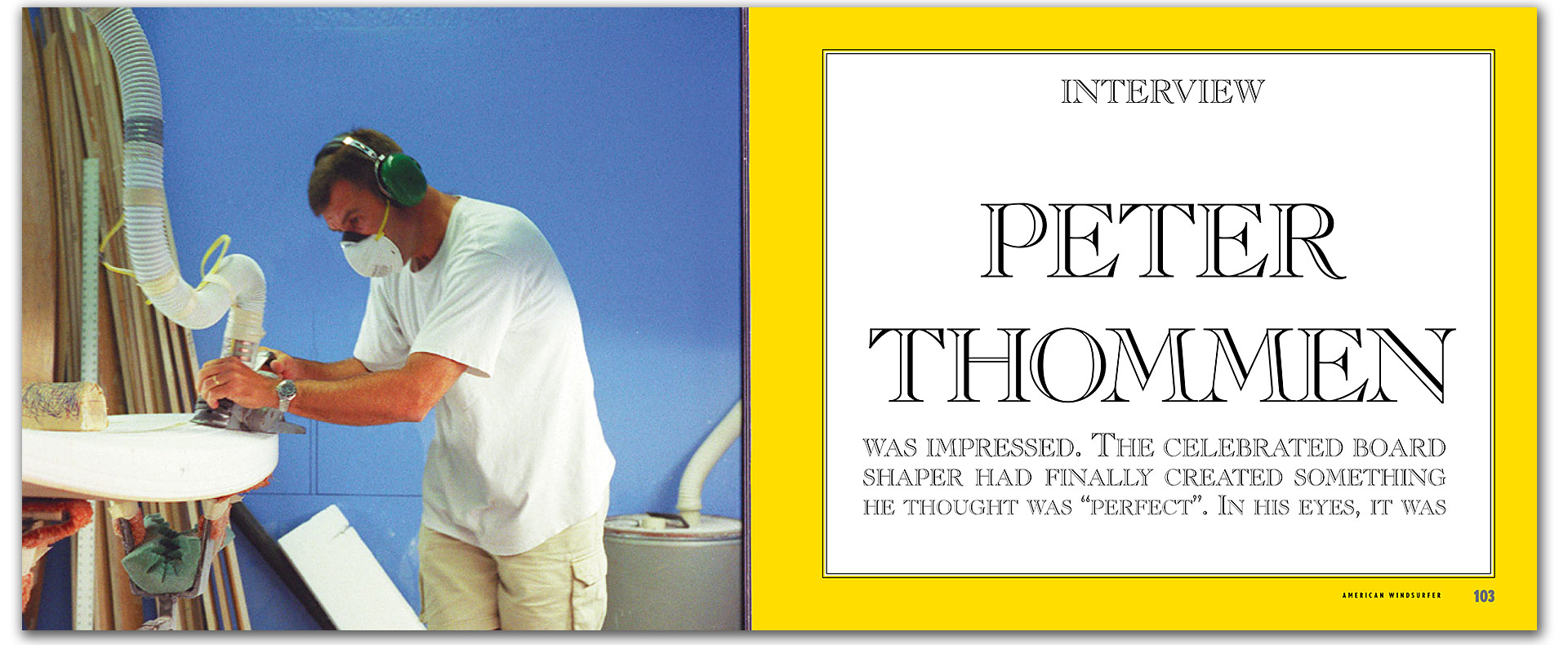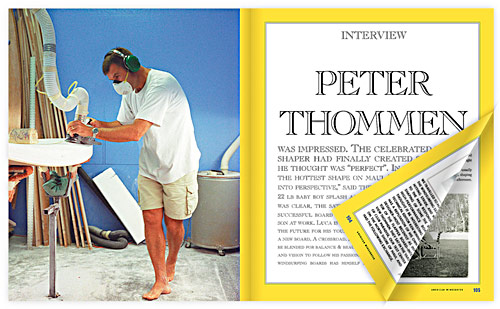
PETER THOMMEN was impressed. The celebrated board shaper had finally created something he thought was “perfect”. In his eyes, it was the hottest shape on Maui. “It puts everything into perspective,” said the shaper as he watched his 22lb baby boy splash across the pool. The transference was clear, the satisfaction that comes from crafting a successful board was no match for the joy of watching his son at work. Luca is a new force to be considered and shaping the future for his young son is not unlike planning the path of a new board. A crossroad. A challenge of Form & Function that must be blended for balance & beauty. It has always been Thommen’s character and vision to follow his passions. Now, the man who has shaped so many F2 windsurfing boards has himself been touched by the work of a . . . MASTER SHAPER
ON MAUI in May, just as the windsurfing season was hitting stride, we visited the man responsible for shaping some the winningest high-performance boards in the world. We thought it be interesting to have Technical editor Ken Winner, who has a reputation of his own as a designer—most recently as inventor of the flapper board—to interview Thommen. They sat in the yard of Club Paradise, our test center on the North Shore of Maui, and had the following exchange.
Ken Winner: American Windsufer readers probably have an idea of who you are, but they don’t know where you’re from. They don’t know how you got into designing boards for F2. So, where are you from?
Peter Thommen: I’m from Biel in Switzerland. I was born in February of ‘59. My parents are Swiss-German, and I am too, from my upbringing. I grew up in a bilingual town, French and German. I went through school, and started on the commercial side of things, in economics. But I never really worked in that field, because when I was 19 I joined the local newspaper and became a journalist. I was working as an editor there for four-and-a-half years.
During that time I picked up windsurfing. That’s pretty much when it came around in central Europe—about ’77, ’78. I tried to develop boards for myself and for my friends. But that was really just a hobby, more than anything else. Then in ’82, I got fed up with working 15 to 18 hours a day at the newspaper and came to Hawaii. That was during the Pan Am days. But I was still working as a free-lance journalist for some Swiss and German magazines.
Advertisement
After three or four months I went back to Switzerland, where my best friend had just started a custom board factory. He didn’t have a clue what the hell was going on. Since I had just come from Hawaii, I had a little better idea, so I shaped for him, and we had some contact with people who were involved in the industry at that time. So a year later, in ‘83, I got offered a job with Hifly, and I ran the R & D workshop in Lake Garda. Then in ‘85, when I feared that Hifly would go down the drain because of how they were spending their money, I had a good head start in looking for another job. That September I signed with Peter Brockhouse and F2.
KW: I posted a question on rec.windsurfing, the internet news group for windsurfing, asking people what they would ask you. It seems a lot of guys wonder how it is they ended up being engineers for Boeing, when they would really much rather be designing boards for F2. [Laughter]
PT: It wasn’t the objective. I never really thought that I would make a career out of windsurfing. It’s just everything came up at the right time. I kind of went with the flow, and for a long time I thought that I’d go back into journalism or something else. Or maybe go back to the university and study architecture. I was really close to letting it go, a couple of times.
Then it just kind of snowballed, and it got better and better. I got other jobs, obviously, and I started to work with people who were really good, and therefore my work just got better. Pretty soon I found myself in a position where I go, “Ho—do I really want to quit that? I don’t think so.” I mean, why?
KW: What would have motivated you to quit, if you had chosen to?
PT: Uhh, I was a bit fed up with the whole thing, with the whole scene.
KW: What aspects of the scene?
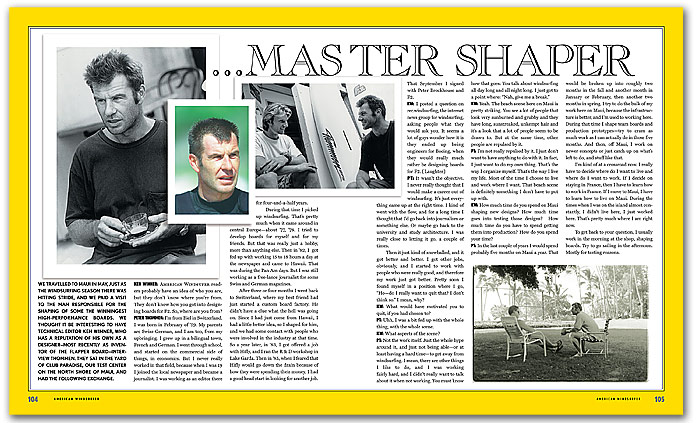
PT: Not the work itself. Just the whole hype around it, and just not being able—or at least having a hard time—to get away from windsurfing. I mean, there are other things I like to do, and I was working fairly hard, and I didn’t really want to talk about it when not working. You must know how that goes: You talk about windsurfing all day long and all night long. I just got to a point where: ‘’Nah, give me a break.’’
KW: Yeah. The beach scene here on Maui is pretty striking. You see a lot of people that look very sunburned and grubby and they have long, sunstreaked, unkempt hair and it’s a look that a lot of people seem to be drawn to. But at the same time, other people are repulsed by it.
PT: I’m not really repulsed by it. I just don’t want to have anything to
do with it. In fact, I just want to do my own thing. That’s the way I organize myself. That’s the way I live my life. Most of the time I choose to live and work where I want. That beach scene is definitely something I don’t have to put up with.
KW: How much time do you spend on Maui shaping new designs? How much time goes into testing those designs? How much time do you have to spend getting them into production? How do you spend your time?
PT: In the last couple of years I would spend probably five months on Maui a year. That would be broken up into roughly two months in the fall and another month in January or February, then another two months in spring. I try to do the bulk of my work here on Maui, because the infrastructure is better, and I’m used to working here. During that time I shape team boards and production prototypes—try to cram as much work as I can actually do in those five months. And then, off Maui, I work on newer concepts or just catch up on what’s left to do, and stuff like that.
I’m kind of at a crossroad now. I really have to decide where do I want to live and where do I want to work. If I decide on staying in France, then I have to learn how to work in France. If I move to Maui, I have to learn how to live on Maui. During the times when I was on the island almost constantly, I didn’t live here, I just worked here. That’s pretty much where I am right now.
To get back to your question, I usually work in the morning at the shop, shaping boards. Try to go sailing in the afternoon. Mostly for testing reasons.
KW: And you have guys who glass the boards for you?
PT: Yes. I do the shaping and do the finish shaping, and everything else is taken care of.
Sponsored Links
KW: And how much time do you have to spend getting a board into production, or fine-tuning the board for production?
PT: Well, first, I’ve never shaped a totally symmetrical board. Nobody does. We know that. I don’t even try to do it any more. I’m usually within a millimeter. I consider that’s fair enough. Hardly anybody can see that anyway.
What I usually do is send the prototype which has been on the water to the factory. Either to Cobra, in Thailand, or to our factory in Austria, and then those guys take it from there. So I don’t really have to do that much to put the board into production. I mean, once it’s tested, that’s the way it’s going to be. I do measure it carefully, and when it gets to the factory they re-measure, to insure that it hasn’t for any reason warped or changed its shape during transport. We began doing that after one experience where we realized that a production board wasn’t working as good as it should have. For some weird reason the shape of the prototype had changed before it got to the factory.
KW: Which board was that?
PT: I can’t answer that. The board wasn’t that bad. It just didn’t work the way I wanted it to work. It was still a good board. It actually sold more than I was thinking it would.
KW: The Axxis 272?
PT: Huh? No! You didn’t like that one?
KW: It wasn’t my favorite.
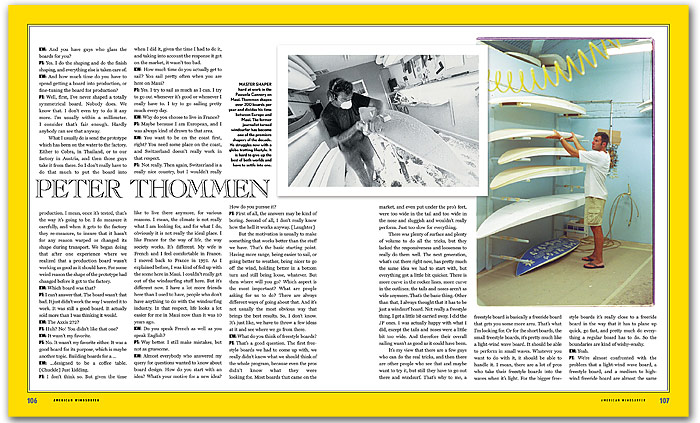
MASTER SHAPER hard at work in the Pauwela Cannery on Maui. Thommen shapes over 200 boards per year and divides his time between Europe and Maui. The former journalist turned windsurfer has become one of the premiere shapers of the decade. He struggles now with a globe trotting lifestyle. It is hard to give up the best of both worlds and have to settle into one.
PT: No. It wasn’t my favorite either. It was a good board for its purpose, which is maybe another topic. Building boards for a …
KW: …designed to be a coffee table. [Chuckle] Just kidding.
PT: I don’t think so. But given the time when I did it, given the time I had to do it, and taking into account the response it got on the market, it wasn’t too bad.
KW: How much time do you actually get to sail? You sail pretty often when you are here on Maui?
PT: Yes. I try to sail as much as I can. I try to go out whenever it’s good or whenever I really have to. I try to go sailing pretty much every day.
KW: Why do you choose to live in France?
PT: Maybe because I am European, and I was always kind of drawn to that area.
KW: You want to be on the coast first, right? You need some place on the coast, and Switzerland doesn’t really work in that respect.
PT: Not really. Then again, Switzerland is a really nice country, but I wouldn’t really like to live there anymore, for various reasons. I mean, the climate is not really what I am looking for, and for what I do, obviously it is not really the ideal place. I like France for the way of life, the way society works. It’s different. My wife is French and I feel comfortable in France.
I moved back to France in 1991. As I explained before, I was kind of fed up with the scene here in Maui. I couldn’t really get out of the windsurfing stuff here. But it’s different now. I have a lot more friends here than I used to have, people who don’t have anything to do with the windsurfing industry. In that respect, life looks a lot easier for me in Maui now than it was 10 years ago.
Advertisement
KW: Do you speak French as well as you speak English?
PT: Way better. I still make mistakes, but not as gruesome.
KW: Almost everybody who answered my query for questions wanted to know about board design. How do you start with an idea? What’s your motive for a new idea? How do you pursue it?
PT: First of all, the answers may be kind of boring. Second of all, I don’t really know how the hell it works anyway. [Laughter]
But the motivation is usually to make something that works better than the stuff we have. That’s the basic starting point. Having more range, being easier to sail, or going better to weather, being nicer to go off the wind, holding better in a bottom turn and still being loose, whatever. But then where will you go? Which aspect is the most important? What are people asking for us to do? There are always different ways of going about that. And it’s not usually the most obvious way that brings the best results. So, I don’t know. It’s just like, we have to throw a few ideas at it and see where we go from there.
KW: What do you think of freestyle boards?
PT: That’s a good question. The first freestyle boards we had to come up with, we really didn’t know what we should think of the whole program, because even the pros didn’t know what they were looking for. Most boards that came on the market, and even put under the pro’s feet, were too wide in the tail and too wide in the nose and sluggish and wouldn’t really perform. Just too slow for everything.
There was plenty of surface and plenty of volume to do all the tricks, but they lacked the responsiveness and looseness to really do them well. The next generation, what’s out there right now, has pretty much the same idea we had to start with, but everything got a little bit quicker. There is more curve in the rocker lines, more curve in the outlines; the tails and noses aren’t as wide anymore. That’s the basic thing. Other than that, I always thought that it has to be just a windsurf board. Not really a freestyle thing. I get a little bit carried away. I did the JP ones. I was actually happy with what I did, except the tails and noses were a little bit too wide. And therefore their overall sailing wasn’t as good as it could have been.
It’s my view that there are a few guys who can do the real tricks, and then there are other people who see that and maybe want to try it, but still they have to go out there and windsurf. That’s why to me, a freestyle board is basically a freeride board that gets you some more area. That’s what I’m looking for. Or for the short boards, the small freestyle boards, it’s pretty much like a light-wind wave board. It should be able to perform in small waves. Whatever you want to do with it, it should be able to handle it. I mean, there are a lot of pros who take their freestyle boards into the waves when it’s light. For the bigger freestyle boards it’s really close to a freeride board in the way that it has to plane up quick, go fast, and pretty much do everything a regular board has to do. So the boundaries are kind of wishy-washy.
KW: Yeah.
PT: We’re almost confronted with the problem that a light-wind wave board, a freestyle board, and a medium to high-wind freeride board are almost the same thing. I guess we could come up with a board that does it all. But the market tells us that we have to have three products, because you sell more. So it’s an economic push to have more specialized boards, as well. You can’t get around that.
KW: I really like the freestyle boards. I think they’re very versatile. I think they have huge range.
PT: Absolutely.
KW: And I could happily use a freestyle board for racing or just cruising or trying to do freestyle or wave sailing. I’d be very happy doing that.
PT: The range of use . . . you can sail them in, pfufff, whatever wind you want. They do perform. Most of those boards are so easy to sail, that it’s the perfect board for somebody that comes from bigger boards. I guess it was a good idea to bring the whole freestyle thing along, but it’s a bummer that the boards are called freestyle. There are people out there who absolutely should be on one, but they’re afraid because the boards are called freestyle.
KW: But they do tend to be a little livelier and a little bit more demanding than your average big freeride board. For example, a person who sails the Ride 277 doesn’t have to be as good as someone who sails something like the Mistral Score 104, which is a pretty light and lively freestyle board. But because it’s so lively, it might be scary for some people.
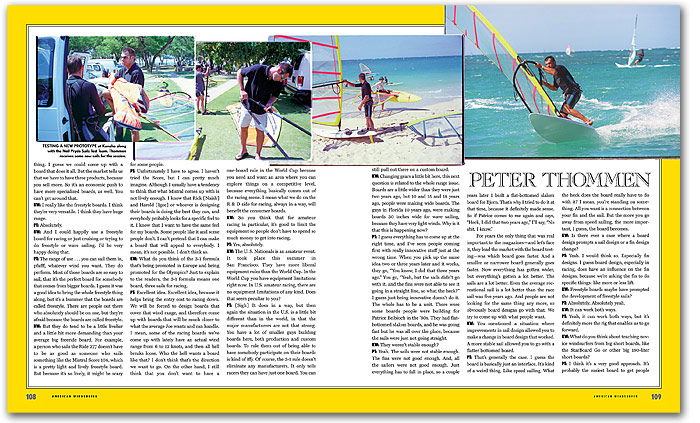
TESTING A NEW PROTOTYPE at Kanaha along with the Neil Pryde Sails Test Team. Thommen receives some new sails for the session.
PT: Unfortunately I have to agree. I haven’t tried the Score, but I can pretty much imagine. Although I usually have a tendency to think that what Mistral comes up with is not lively enough. I know that Rick [Naish] and Harold [Igee] or whoever is designing their boards is doing the best they can, and everybody probably looks for a specific feel to it. I know that I want to have the same feel for my boards. Some people like it and some people don’t. I can’t pretend that I can make a board that will appeal to everybody. I mean, it’s not possible. I don’t think so.
KW: What do you think of the 3-1 formula that’s being promoted in Europe and being promoted for the Olympics? Just to explain to the readers, the 3-1 formula means one board, three sails for racing.
PT: Excellent idea. Excellent idea, because it helps bring the entry cost to racing down. We will be forced to design boards that cover that wind range, and therefore come up with boards that will be much closer to what the average Joe wants and can handle. I mean, some of the racing boards we’ve come up with lately have an actual wind range from 6 to 12 knots, and then all hell breaks loose. Who the hell wants a board like that? I don’t think that’s the direction we want to go. On the other hand, I still think that you don’t want to have a one-board rule in the World Cup because you need and want an area where you can explore things on a competitive level, because everything basically comes out of the racing scene. I mean what we do on the R & D side for racing, always in a way, will benefit the consumer boards.
KW: So you think that for amateur racing in particular, it’s good to limit the equipment so people don’t have to spend so much money to get into racing.
PT: Yes, absolutely.
KW: The U. S. Nationals is an amateur event. It took place this summer in
San Francisco. They have more liberal equipment rules than the World Cup. In the World Cup you have equipment limitations right now. In U.S. amateur racing, there are no equipment limitations of any kind. Does that seem peculiar to you?
PT: [Sigh] It does in a way, but then again the situation in the U.S. is a little bit different than in the world, in that the major manufacturers are not that strong. You have a lot of smaller guys building boards here, both production and custom boards. To rule them out of being able to have somebody participate on their boards is kind of iffy. Of course, the 3-1 rule doesn’t eliminate any manufacturers. It only tells racers they can have just one board. You can still pull out there on a custom board.
KW: Changing gears a little bit here, this next question is related to the whole range issue. Boards are a little wider than they were just two years ago, but 10 and 15 and 18 years ago, people were making wide boards. The guys in Florida 10 years ago, were making boards 30 inches wide for wave sailing, because they have very light winds. Why is it that this is happening now?
PT: I guess everything has to come up at the right time, and I’ve seen people coming first with really innovative stuff just at the wrong time. When you pick up the same idea two or three years later and it works, they go, ‘’You know, I did that three years ago.’’ You go, ‘’Yeah, but the sails didn’t go with it, and the fins were not able to see it going in a straight line, so what the heck?’’ I guess just being innovative doesn’t do it. The whole has to be a unit. There were some boards people were building for Patrice Belbioch in the ‘80s. They had flat-bottomed slalom boards, and he was going fast but he was all over the place, because the sails were just not going straight.
KW: They weren’t stable enough?
PT: Yeah. The sails were not stable enough. The fins were not good enough. And, all the sailors were not good enough. Just everything has to fall in place, so a couple years later I built a flat-bottomed slalom board for Bjorn. That’s why I tried to do it at that time, because it definitely made sense. So if Patrice comes to me again and says, “Heck, I did that two years ago,’’ I’ll say, “No shit, I know.”
For years the only thing that was real important to the magazines—and let’s face it, they lead the market with the board testing—was which board goes faster. And a smaller or narrower board generally goes faster. Now everything has gotten wider, but everything’s gotten a lot better. The sails are a lot better. Even the average recreational sail is a lot better than the race sail was five years ago. And people are not looking for the same thing any more, so obviously board designs go with that. We try to come up with what people want.
KW: You mentioned a situation where improvements in sail design allowed you to make a change in board design that worked. A more stable sail allowed you to go with a flatter bottomed board.
PT: That’s generally the case. I guess the board is basically just an interface. It’s kind of a weird thing. Like speed sailing. What the heck does the board really have to do with it? I mean, you’re standing on something. All you want is a connection between your fin and the sail. But the more you go away from speed sailing, the more important, I guess, the board becomes.
KW: Is there ever a case where a board design prompts a sail design or a fin design change?
PT: Yeah. I would think so. Especially fin designs. I guess board design, especially in racing, does have an influence on the fin designs, because we’re asking the fin to do specific things: like more or less lift.
KW: Freestyle boards maybe have prompted the development of freestyle sails?
PT: Absolutely. Absolutely yeah.
KW: It can work both ways.
PT: Yeah, it can work both ways, but it’s
definitely more the rig that enables us to go forward.
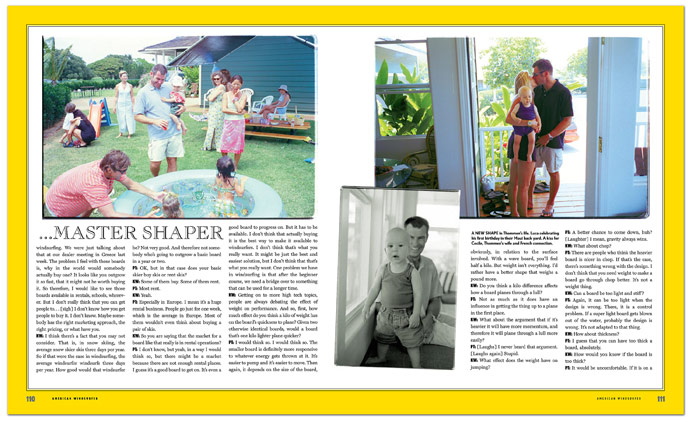
A NEW SHAPE in Thommen’s life. Luca celebrating his first birthday in their Maui back yard. A kiss for Cecile, Thommen’s wife and French connection.
KW: What do you think about teaching novice windsurfers from big short boards, like the StarBoard Go or other big 180-liter short boards?
PT: I think it’s a very good approach. It’s probably the easiest board to get people windsurfing. We were just talking about that at our dealer meeting in Greece last week. The problem I feel with those boards is, why in the world would somebody actually buy one? It looks like you outgrow it so fast, that it might not be worth buying it. So therefore, I would like to see those boards available in rentals, schools, wherever. But I don’t really think that you can get people to. . . [sigh] I don’t know how you get people to buy it. I don’t know. Maybe somebody has the right marketing approach, the right pricing, or what have you.
KW: I think there’s a fact that you may not consider. That is, in snow skiing, the average snow skier skis three days per year. So if that were the case in windsurfing, the average windsurfer windsurfs three days per year. How good would that windsurfer be? Not very good. And therefore not somebody who’s going to outgrow a basic board in a year or two.
PT: OK, but in that case does your basic skier buy skis or rent skis?
KW: Some of them buy. Some of them rent.
PT: Most rent.
KW: Yeah.
PT: Especially in Europe. I mean it’s a huge rental business. People go just for one week, which is the average in Europe. Most of them wouldn’t even think about buying a pair of skis.
KW: So you are saying that the market for a board like that really is in rental operations?
PT: I don’t know, but yeah, in a way I would think so, but there might be a market because there are not enough rental places. I guess it’s a good board to get on. It’s even a good board to progress on. But it has to be available. I don’t think that actually buying it is the best way to make it available to windsurfers. I don’t think that’s what you really want. It might be just the best and easiest solution, but I don’t think that that’s what you really want. One problem we have in windsurfing is that after the beginner course, we need a bridge over to something that can be used for a longer time.
KW: Getting on to more high tech topics, people are always debating the effect of weight on performance. And so, first, how much effect do you think a kilo of weight has on the board’s quickness to plane? Given two otherwise identical boards, would a board that’s one kilo lighter plane quicker?
PT: I would think so. I would think so. The smaller board is definitely more responsive to whatever energy gets thrown at it. It’s easier to pump and it’s easier to move. Then again, it depends on the size of the board, obviously, in relation to the surface involved. With a wave board, you’ll feel half a kilo. But weight isn’t everything. I’d rather have a better shape that weighs a pound more.
KW: Do you think a kilo difference affects how a board planes through a lull?
PT: Not as much as it does have an
influence in getting the thing up to a plane in the first place.
KW: What about the argument that if it’s heavier it will have more momentum, and therefore it will plane through a lull more easily?
PT: [Laughs] I never heard that argument. [Laughs again] Stupid.
KW: What effect does the weight have on jumping?
PT: A better chance to come down, huh? [Laughter] I mean, gravity always wins.
KW: What about chop?
PT: There are people who think the heavier board is nicer in chop. If that’s the case, there’s something wrong with the design. I don’t think that you need weight to make a board go through chop better. It’s not a weight thing.
KW: Can a board be too light and stiff?
PT: Again, it can be too light when the design is wrong. There, it is a control problem. If a super light board gets blown out of the water, probably the design is wrong. It’s not adapted to that thing.
KW: How about thickness?
PT: I guess that you can have too thick a board, absolutely.
KW: How would you know if the board is too thick?
PT: It would be uncomfortable. If it is on a wave board, it would not be as responsive and as smooth as a board that has some give.
KW: Is the stiffness of the boards something you try to build into the production boards? Or do you just make them as stiff as you are accustomed to making them and not worry about it too much?
PT: I have limited influence on the lay-up of production boards, obviously, but there are other criteria that come into play and one of them is to make the damn things long enough that they don’t break and you know that warranty returns are basically the worst that can happen to a board manufacturer. In that respect, we try to make sure first of all that the thing doesn’t break. And therefore some of the boards might be a bit too stiff. Then again you have to be probably a fairly good sailor to really feel that difference between a board that is stiff a little bit and a board that is just too stiff. I personally like wave boards that can flex. I don’t like wave boards that are really stiff.
KW: What do you think of the boards that are real thin in the nose? Have you ever tried that with any board you’ve shaped?
PT: Yeah. I usually try stuff that comes around, just to see what it does, just to see if my assumption of what it does is what I think. I think you don’t need that. I don’t think it brings real benefit. Okay, it might be a little bit lighter up there, and there might be a little less movement, but I do think that volume at the nose does something for you. Just to get rid of it, just to make the board lighter…no that’s not good enough. It’s always a compromise. I mean, you don’t want to give up everything just to have more of another thing. I don’t think so.
KW: How many prototypes do you build a year?
PT: Between production boards, prototypes, team boards, a few custom boards for friends, stuff like that…I built 210 boards last year.
KW: 210!
PT: Yeah.
KW: That’s a lot of boards.
PT: That’s why I usually say every board I don’t build is a good board. [laughter] But it’s easy to make a board; it’s more demanding to come up with a good product. I’m working with about 10 guys on the tour, so that jacks it up quite quickly. I’m responsible for the whole JP line and all the wave stuff, the Axxis and Ride stuff and all the racing stuff for F2. That’s a lot of different models, and the lifespans are getting shorter and shorter, so it just takes more time.
KW: I think the magazine wants us to fight about board designs. [laughs]
PT: There’s no reason to fight about it. It’s just different approaches to things. People have different goals. Different tasks within the industry. I mean, I’m building boards for a major company. Building boards for people who are pretty much as good as it gets. Be it Bjorn, be it Jason. It can’t be my first goal just to come up with something new. I have to make sure that whatever I put in production, or whatever boards I give to racers, really work.
KW: The, uh, the debate over flaps…
PT: Hey hey!
KW: …still seems to be going.
PT: Absolutely. I just had the same questions asked by two Italian magazine editors who were at our dealer meeting. Flap? No Flap?
You know more about the flap than I do. It is interesting and kind of a bummer that I built a few boards with flaps, and they all ended up in the dumpster because I didn’t like them. [Chuckle] Maybe it’s just because I didn’t get it right, but I build boards without the flapper and I like those better.
I won’t go so far as to say the flapper is a gimmick, but to me the flapper interrupts the flow design. And when I thought about production, I didn’t really want to see it on the board. What happens if you have a pit bull, and it chews it up? You have a board that can’t be used anymore. It’s kind of a bummer, you know. [laughter]
KW: You’ll just have to go buy another F2.
[more laughter]
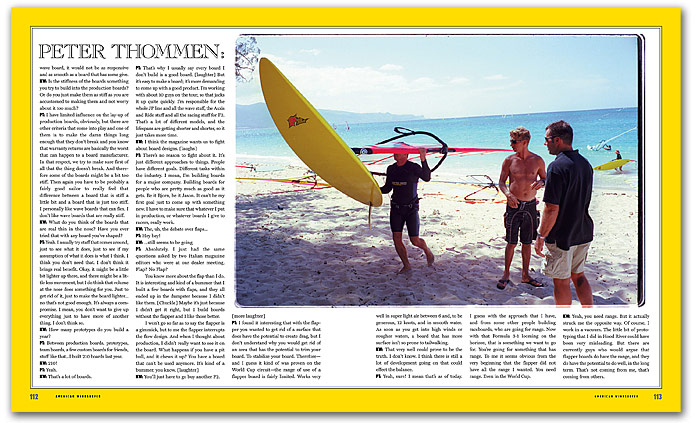
PT: I found it interesting that with the flapper you wanted to get rid of a surface that does have the potential to create drag, but I don’t understand why you would get rid of an area that has the potential to trim your board. To stabilize your board. Therefore—and I guess it kind of was proven on the World Cup circuit—the range of use of a flapper board is fairly limited. Works very well in super light air between 6 and, to be generous, 12 knots, and in smooth water. As soon as you get into high winds or rougher waters, a board that has more surface isn’t so prone to tailwalking.
KW: That very well could prove to be the truth. I don’t know. I think there is still a lot of development going on that could effect the balance.
PT: Yeah, sure! I mean that’s as of today. I guess with the approach that I have, and from some other people building raceboards, who are going for range. Now with that Formula 3-1 looming on the horizon, that is something we want to go for. You’re going for something that has range. To me it seems obvious from the very beginning that the flapper did not have all the range I wanted. You need range. Even in the World Cup.
KW: Yeah, you need range. But it actually struck me the opposite way. Of course, I work in a vacuum. The little bit of prototyping that I did in Hood River could have been very misleading. But there are currently guys who would argue that flapper boards do have the range, and they do have the potential to do well, in the long term. That’s not coming from me, that’s coming from others.
PT: Well, time will tell. And like I said before, there are applications and conditions where a flapper board is probably better. But it’s just not the real world. I guess the real world is when you mix everything in a bag and then it has to perform everywhere. Especially the way things are going towards a one-board class. You just need something that performs all the time. But I’m no God when it comes to board design. I have no clue! [laughs]
KW: Can you say what design trends you see in boards in the next couple years?
PT: You will see more range in every discipline, from race to freeride to freestyle. Easier to sail and put out more fun. Probably a little wider board—not super-wide boards; I don’t think that’s the answer to all the questions. But the emphasis will definitely be on maneuverability, control and ease of sailing. I think that’s where we’re heading.
KW: You used to sail with Bjorn quite a bit testing boards. Do you still do that?
PT: Ahh, no. The bugger is way too quick for me.
KW: So, 10 years ago he wasn’t quite as quick as he is now, or you’ve slowed down.
PT: I guess I’ve slowed down a lot. I don’t sail that much anymore. But we still do test together. We still come to a result.
KW: Who does he normally test boards with? If you have a new design and you want Bjorn to test it, who does he sail with?
PT: Bjorn has a fairly unique capacity. He can actually test stuff by himself, and I trust his judgement. When he says that board is faster than the other one, it is faster. Then there are other people that he tests with. There’s Ant Baker and Peter Volwater, just because I’m working with those guys as well, and then there is Victor at the factory, he’s fairly quick. But in the end Bjorn decides on his own what he’s going to use and what’s better for him. It might not be the best board but it is a better board for him. I definitely can make a distinction between a good board for Bjorn and a good board for other racers and a good production board.
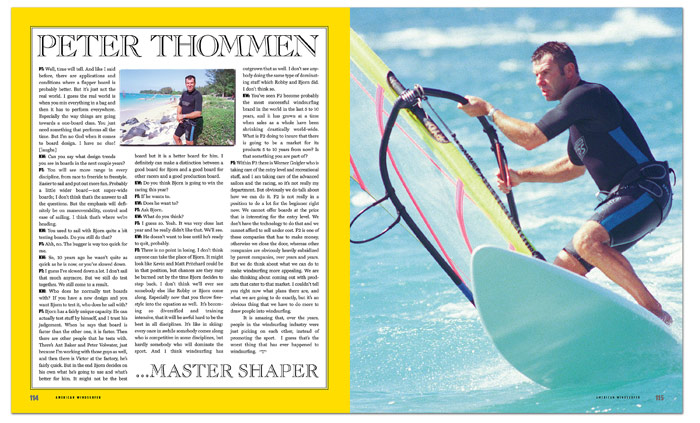
KW: Do you think Bjorn is going to win the racing this year?
PT: If he wants to.
KW: Does he want to?
PT: Ask Bjorn.
KW: What do you think?
PT: I guess so. Yeah. It was very close last year and he really didn’t like that. We’ll see.
KW: He doesn’t want to lose until he’s ready to quit, probably.
PT: There is no point in losing. I don’t think anyone can take the place of Bjorn. It might look like Kevin and Matt Pritchard could be in that position, but chances are they may be burned out by the time Bjorn decides to step back. I don’t think we’ll ever see somebody else like Robby or Bjorn come along. Especially now that you throw freestyle into the equation as well. It’s becoming so diversified and training intensive, that it will be awful hard to be the best in all disciplines. It’s like in skiing: every once in awhile somebody comes along who is competitive in some disciplines, but hardly somebody who will dominate the sport. And I think windsurfing has outgrown that as well. I don’t see anybody doing the same type of dominating stuff which Robby and Bjorn did. I don’t think so.
KW: You’ve seen F2 become probably the most successful windsurfing brand in the world in the last 5 to 10 years, and it has grown at a time when sales as a whole have been shrinking drastically world-wide. What is F2 doing to insure that there is going to be a market for its products 5 to 10 years from now? Is that something you are part of?
PT: Within F2 there is Werner Gnigler who is taking care of the entry level and recreational stuff, and I am taking care of the advanced sailors and the racing, so it’s not really my department. But obviously we do talk about how we can do it. F2 is not really in a position to do a lot for the beginner right now. We cannot offer boards at the price that is interesting for the entry level. We don’t have the technology to do that and we cannot afford to sell under cost. F2 is one of these companies that has to make money, otherwise we close the door, whereas other companies are obviously heavily subsidized by parent companies, over years and years. But we do think about what we can do to make windsurfing more appealing. We are also thinking about coming out with products that cater to that market. I couldn’t tell you right now what plans there are, and what we are going to do exactly, but it’s an obvious thing that we have to do more to draw people into windsurfing.
It is amazing that, over the years, people in the windsurfing industry were just picking on each other, instead of promoting the sport. I guess that’s the worst thing that has ever happened to windsurfing.
Captions
MASTER SHAPER hard at work in the Pauwela Cannery on Maui. Thommen shapes over 200 boards per year and divides his time between Europe and Maui. The former journalist turned windsurfer has become one of the premiere shapers of the decade. He struggles now with a globe trotting lifestyle. It is hard to give up the best of both worlds and have to settle into one.
Have something to add to this story? Share it in the comments.


